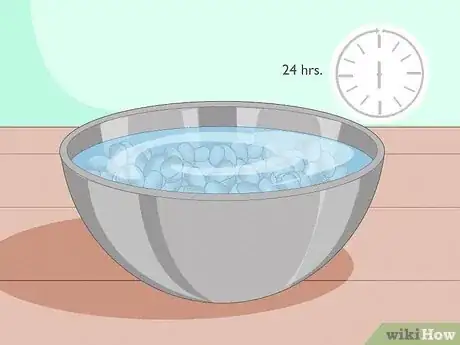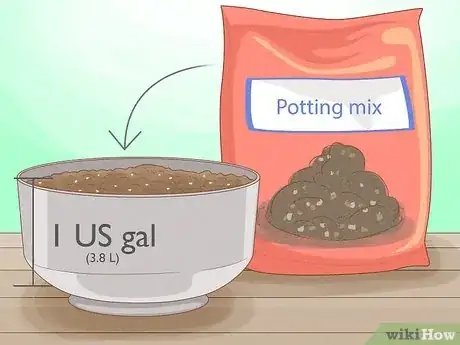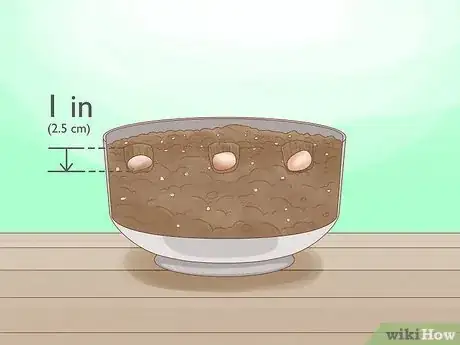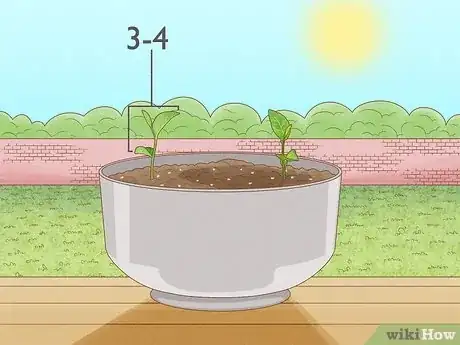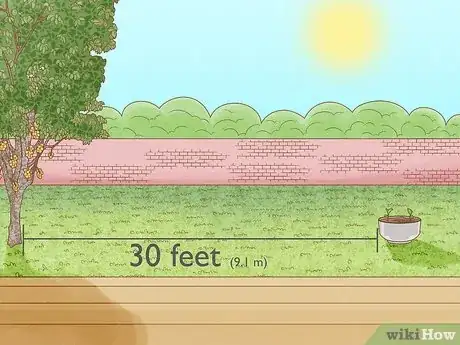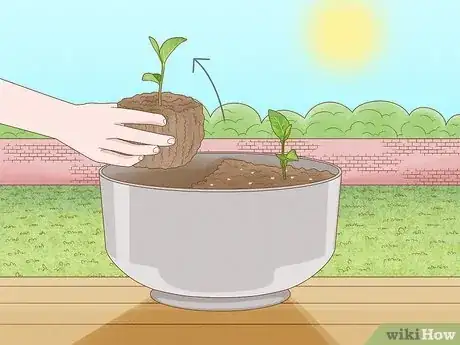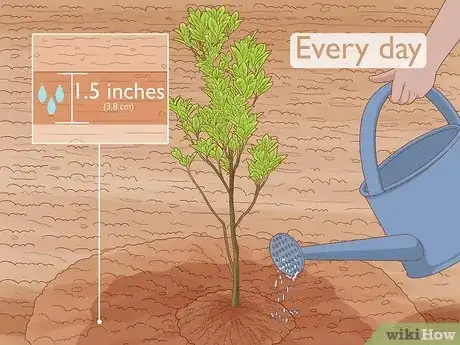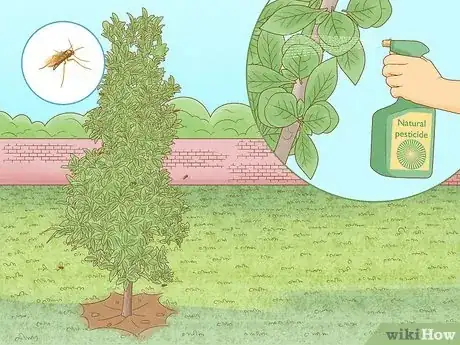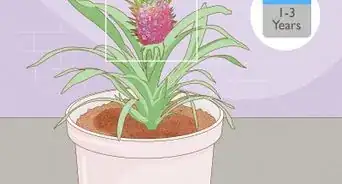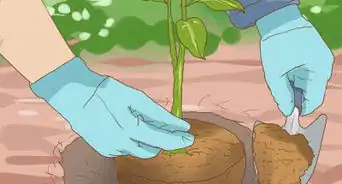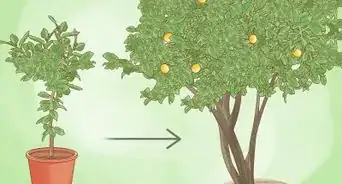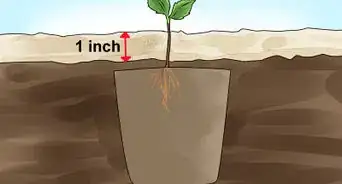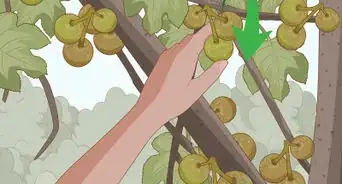X
This article was co-authored by Maggie Moran and by wikiHow staff writer, Hunter Rising. Maggie Moran is a Professional Gardener in Pennsylvania.
There are 9 references cited in this article, which can be found at the bottom of the page.
This article has been viewed 42,802 times.
Jackfruit are large, spiny, melon-shaped fruit originating from Southeast Asia. The pulp of the fruit can be used as a meat substitute since it has a similar texture to pork. If you live in USDA Zones 10 - 12, you too can grow a tree that produces jackfruit.[1] By starting your seeds in a pot and transplanting them outdoors, after a few years you’ll have a tree bearing many fruit!
Steps
Part 1
Part 1 of 3:
Germinating Seeds in Pots
-
1Purchase jackfruit seeds. Check with your local nursery or an Asian market to see if they carry jackfruit seeds. If not, you can find seeds available to purchase online.[2]
- If you have access to ripe jackfruit, you can also harvest seeds from the fruit. Rinse the seeds with warm water to remove the sticky pulp.
-
2Soak the seeds in water for 24 hours. Place your seeds in a bowl or container with lukewarm water. Let them sit for a full day before sowing them. Soaking seeds will speed up the germination process and make your seedlings grow faster.[3]Advertisement
-
3Fill a 1 US gal (3.8 L) pot with potting mix. Use a plastic pot with drainage holes so water can easily flow out from the bottom. Use a well-draining potting mix with perlite, sand, and organic compost to achieve the best drainage in your pot.[4]
- Premixed potting soil can be purchased at gardening stores, or you can make your own.
-
4Plant 3 seeds 1 in (2.5 cm) deep in the soil. Space the seeds evenly near the center of the pot. Don’t let the seeds grow near the edges, otherwise the roots may not develop fully. Cover the seeds and press down slightly to compact the potting mix.[5]
- You can plant more seeds in the pot, but they will be competing for resources and may not grow as well.
-
5Water the seeds every day. Keep the soil moist, but make sure that it is not overwatered. Stick your finger into the soil up to the first knuckle to feel if it's wet. If it isn’t, water the seeds.[6]
- Even though jackfruit grows in humid, tropical regions with a lot of rainfall, too much water can cause the seeds and roots to rot.
- Try to use untreated or distilled water when starting off your seedlings.
-
6Keep the pot in a warm, sunny area. If you can, keep the pot outdoors during the warmest parts of the day. When the temperature gets near freezing, bring the pot indoors and keep it on a windowsill or near a window so it receives sunlight.
- A heat lamp indoors is a great substitute if the weather outside is not cooperating.
-
7Thin down to 1 healthy seedling after they’ve started germinating. It will take 2-3 weeks for your seedlings to germinate. Look for seedlings that have grown the tallest and have healthy looking leaves. Remove the weaker seedlings by gently pulling them out of the soil.[7]
- Avoid using seedlings that are spindly or have grown near the edge of the pot. Their root systems will not have spread and developed fully.
Advertisement
Part 2
Part 2 of 3:
Transplanting the Seedling Outside
-
1Move the seedling outside after it forms 3 to 4 true leaves. The seedling usually takes 3-4 weeks to germinate and you’ll begin to see leaves forming. True leaves will look large and green without ridges and grow taller than the seed leaves.[8]
-
2Find an area 30 feet (9.1 m) away from other trees to plant the tree. Jackfruit trees can grow up to 100 feet (30 m) tall if left alone, so they need space to develop and grow. Keep your planting area away from other trees so they aren’t competing for resources.[9]
- Avoid planting a tree near your house since the roots will grow out and could cause underground damage.
- Find an area away from high winds so your tree can develop safely.
-
3Dig a 2 × 2 × 2 ft (0.61 × 0.61 × 0.61 m) hole in well-draining soil. Use a shovel to dig a square- or circular-shaped hole. Inspect the soil to see if it has sand or clay mixed in since this will help it drain quickly.[10]
- Jackfruit prefer soil that is between 5 - 7 pH.
- Add compost into the soil to give your seedling natural nutrients.
- You can always make your soil drain better by mixing in sand or compost.
-
4Remove the seedling from the pot carefully and place it in the ground. Squeeze the edges of the pot to loosen the soil. Grab the seedling by the base and gently pull and twist to remove it from the pot. Keep the base of the seedling level with the ground.[11]
-
5Fill the soil in around the tree, making a mound at the base of the trunk. Pat the topsoil with the bottom of your shovel to compact it onto the roots. Form a cone-shaped mound around the trunk of the tree so water can run off the soil.[12]
- You can immediately add mulch around the tree if you want to retain moisture for longer.
Advertisement
Part 3
Part 3 of 3:
Caring for Your Tree
-
1Water your tree every day. Newly planted trees need to have water so their roots can establish. Use a garden hose to water at the base of your tree’s trunk. Make sure the soil is damp 1.5 inches (3.8 cm) deep, but do not overwater.[13]
- During dry periods, water your tree twice a day.
-
2Remove weeds around the tree once a month. Pull weeds by hand if you can to avoid using herbicides that could damage your tree. You can also make your own weed killer with vinegar or rock salt to kill the weeds surrounding the tree.[14]
- Weeds will take essential nutrients from the soil if they are left in the ground.
- Mulching around the tree will help prevent weed growth.
- If you use herbicides or pesticides to protect your tree, make sure to wash the fruit completely before you eat them.
-
3Layer mulch around the tree if temperatures drop below 35 °F (2 °C). Only jackfruit trees that have acclimated to the climate can survive during the frost and winter. Place more mulch around the tree to insulate the roots for the winter.[15]
-
4Fertilize the tree every 6 months. During your tree's first year, use 30 grams (1.1 oz) of a fertilizer that’s an 8:4:2:1 ratio of nitrogen, phosphorus, potassium, and magnesium. Every 6 months for the first 2 years, double the amount of fertilizer you use with the same mix.[16]
- After your tree is 2 years old, use 1 kilogram (2.2 lb) of a fertilizer with a 4:2:4:1 ratio.
- Water the tree immediately after you fertilize so it can soak into the soil.
-
5Use an organic pesticide to deter bugs. Although jackfruit is resistant to most fungal diseases, the jackfruit borer is an insect that can destroy every part of your tree. Spray the tree with a natural pesticide so it does not damage the tree.[17]
- Purchase a natural pesticide from your local garden store or make your own at home.
- If you notice fruit flies around your tree, wrap the developing fruits with paper bags or newspapers.
- Wash all your fruit thoroughly after spraying pesticides.
-
6Prune the jackfruit tree in spring to keep your tree below 20 feet (6.1 m). Jackfruit will grow tall and produce fruit that’s out of reach. Every season, use a pair of loppers or hand shears to trim your tree back to control the size.[18]
- When the tree reaches 12 feet (3.7 m) tall, cut the trunk back by one-third to promote outward growth rather than upward growth.
-
7Harvest fruit after 3 to 4 years. After the third or fourth year, your tree will begin developing viable fruit. Within 4 to 5 months, young fruit will begin to ripen and can be picked from the tree. They will have a sweet odor and have a green or yellowish tint.[19]
- Unripe fruit can be picked as used as a meat substitute after 2-3 months.
- Ripe jackfruit has a sweeter flavor and can be eaten alone or in recipes.
Advertisement
Expert Q&A
Did you know you can get expert answers for this article?
Unlock expert answers by supporting wikiHow
-
QuestionWhat climate does jackfruit grow in?
 Maggie MoranMaggie Moran is a Professional Gardener in Pennsylvania.
Maggie MoranMaggie Moran is a Professional Gardener in Pennsylvania.
Home & Garden Specialist
-
QuestionHow long does it take for a jackfruit tree to bear fruit?
 Maggie MoranMaggie Moran is a Professional Gardener in Pennsylvania.
Maggie MoranMaggie Moran is a Professional Gardener in Pennsylvania.
Home & Garden Specialist
-
QuestionWhat are the benefits of eating jackfruit?
 Maggie MoranMaggie Moran is a Professional Gardener in Pennsylvania.
Maggie MoranMaggie Moran is a Professional Gardener in Pennsylvania.
Home & Garden Specialist
Advertisement
References
- ↑ http://balconygardenweb.com/how-to-grow-jackfruit-complete-growing-guide/
- ↑ http://balconygardenweb.com/how-to-grow-jackfruit-complete-growing-guide/
- ↑ https://plantinstructions.com/tropical-fruit/how-to-grow-jackfruit/
- ↑ https://youtu.be/HZTlHpvrVUU?t=7m1s
- ↑ https://youtu.be/HZTlHpvrVUU?t=7m50s
- ↑ http://balconygardenweb.com/how-to-grow-jackfruit-complete-growing-guide/
- ↑ http://balconygardenweb.com/how-to-grow-jackfruit-complete-growing-guide/
- ↑ https://garden.org/courseweb/vegetables/CLASS3/c3p9.html
- ↑ http://rfcarchives.org.au/Next/Fruits/Jakfruit/JackfruitCultiv2-84.htm
- ↑ http://rfcarchives.org.au/Next/Fruits/Jakfruit/JackfruitCultiv2-84.htm
- ↑ http://balconygardenweb.com/how-to-grow-jackfruit-complete-growing-guide/
- ↑ http://rfcarchives.org.au/Next/Fruits/Jakfruit/JackfruitCultiv2-84.htm
- ↑ http://balconygardenweb.com/how-to-grow-jackfruit-complete-growing-guide/
- ↑ http://balconygardenweb.com/how-to-grow-jackfruit-complete-growing-guide/
- ↑ http://balconygardenweb.com/how-to-grow-jackfruit-complete-growing-guide/
- ↑ https://plantinstructions.com/tropical-fruit/how-to-grow-jackfruit/
- ↑ http://rfcarchives.org.au/Next/Fruits/Jakfruit/JackfruitCultiv2-84.htm
- ↑ http://balconygardenweb.com/how-to-grow-jackfruit-complete-growing-guide/
- ↑ http://balconygardenweb.com/how-to-grow-jackfruit-complete-growing-guide/
- ↑ https://www.hort.purdue.edu/newcrop/morton/jackfruit_ars.html
About This Article
Advertisement

